
RIO
0.7900


US consumer inflation held steady in July, with an uptick in underlying price pressures that could spell trouble for President Donald Trump and his promises of an economic boom.
The 2.7 percent consumer price index (CPI) figure was probably not high enough to derail a potential interest rate cut in September, but Trump responded with yet another direct attack on Federal Reserve chair Jerome Powell, whom he blames for not lowering rates fast enough.
In a separate Truth Social post, Trump claimed that "even at this late stage, Tariffs have not caused Inflation."
But analysts warn that the pass-through from Trump's duties is not yet complete.
CPI rose 2.7 percent from a year ago in July, the same rate as in June, said the Department of Labor on Tuesday.
But, excluding the volatile food and energy segments, "core" CPI in July accelerated to 0.3 percent on a month-on-month basis, up from a 0.2-percent rise before.
From a year ago, underlying inflation rose 3.1 percent, picking up pace too from 2.9 percent in June.
"Many companies have announced plans to pass along higher costs to their customers soon," said Navy Federal Credit Union chief economist Heather Long.
"It's only a matter of time before more goods become more expensive," she added in a note.
Analysts are closely watching CPI numbers amid increasing fears over the reliability of economic data from the Trump administration, which fired the head of the Bureau of Labor Statistics recently after a jobs report showed significantly lower hiring numbers.
They are also monitoring for weakening amid Trump's trade war, as he tries to reshape the global economy.
- 'More price hikes' -
The president has ordered a 10-percent tariff on goods from almost all trading partners. For dozens of economies including Japan, South Korea and the European Union, this level rose to various higher rates last Thursday.
Sectors that have been targeted individually -- or are under investigation by officials -- have been spared from these countrywide levies so far. But Trump has been progressively imposing steep duties on different sectors.
"Brace for more price hikes as we move into late summer and early fall," said KPMG chief economist Diane Swonk.
"The pass-through of the most recent rise in tariffs is expected to be faster than the initial round because there was less time to stockpile," she added.
While Swonk believes a September interest rate cut remains possible, she expects this would only happen if "if we see much weaker demand, notably from the labor market, between now and then."
CME's FedWatch tool has investors seeing a 92.2-percent chance of a quarter-point cut at the Fed's next policy meeting in September.
On Tuesday, Trump said he was considering allowing "a major lawsuit against" Powell to proceed, taking aim at the Fed chair's oversight of the central bank's renovations in Washington.
Trump has repeatedly lashed out at Powell recently, floating the idea of ousting him over the Fed's revamp, as he criticized the bank's decisions to keep rates unchanged this year.
Tuesday's headline CPI figure was a touch below the 2.8-percent rate expected in a median forecast of analysts surveyed by Dow Jones Newswires and The Wall Street Journal.
But experts have cautioned that a cooler figure could also point to a slowing economy.
For now, policymakers are trying to balance between supporting the jobs market and keeping cost increases under control.
While businesses have stocked up in anticipation of Trump's tariff hikes this year and may not have raised consumer costs directly, economists warn that companies will not be able to do so indefinitely.
While the indexes for energy and gasoline dropped in the month, shelter costs rose in July.
Indexes that rose over the month included medical care, airline fares and household furnishings, the Labor Department report showed.
"It remains the case that prices have risen the most since January for goods that are primarily imported," said Samuel Tombs, chief US economist at Pantheon Macroeconomics.
D.Pan--ThChM